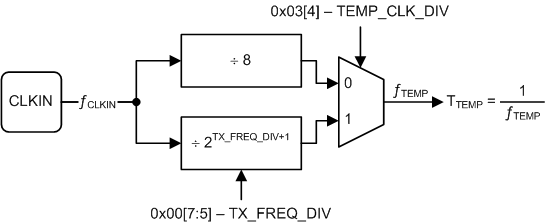SNAS648C October 2014 – February 2023 TDC1000
PRODUCTION DATA
- 1 Features
- 2 Applications
- 3 Description
- 4 Revision History
- 5 Pin Configuration and Functions
- 6 Specifications
- 7 Parameter Measurement Information
-
8 Detailed Description
- 8.1 Overview
- 8.2 Functional Block Diagram
- 8.3 Feature Description
- 8.4 Device Functional Modes
- 8.5 Programming
- 8.6 Register Maps
- 9 Application and Implementation
- 10Device and Documentation Support
- 11Mechanical, Packaging, and Orderable Information
8.3.8 Temperature Sensor
Accurate measurements of flow, level, and concentration require compensation for the temperature dependency of the speed of sound in the medium. The TDC1000 provides two temperature sensor connections, allowing to measure up to two locations with RTDs, as shown in #SNAS6489220.
 Figure 8-9 Temperature Sensor Measurement
Figure 8-9 Temperature Sensor MeasurementThe temperature sensor block supports PT1000 or PT500 sensors. The type of RTD used must be selected in the TEMP_RTD_SEL bit of the CONFIG_3 register. The system requires a temperature-stable external reference resistor (RREF). If the RTD type is PT500, then RREF should be 500 Ω. If the RTD type is PT1000, then RREF should be 1 kΩ. The reference resistor needs to have either a low temperature coefficient or be calibrated for temperature shift.
The logic timing in a temperature measurement is controlled by the TEMP_CLK_DIV bit in the CONFIG_3 register. As shown in #SNAS6484652, the external clock can be divided by 8 or by the value resulting from the TX_FREQ_DIV field configuration in the CONFIG_0 register. TI recommends to operate the temperature measurement block at frequencies of 1 MHz or less.
 Figure 8-10 Timing Source for the Temperature Measurement
Figure 8-10 Timing Source for the Temperature Measurement